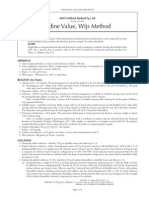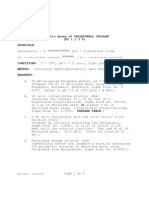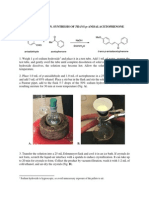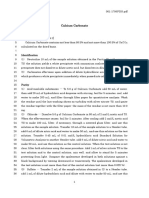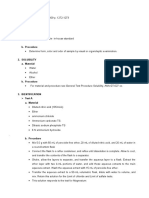Enzymatic Assay of XYLANASE (EC 3.2.1.8) Principle
Enzymatic Assay of XYLANASE (EC 3.2.1.8) Principle
Uploaded by
Anindya Rahma O KCopyright:
Available Formats
Enzymatic Assay of XYLANASE (EC 3.2.1.8) Principle
Enzymatic Assay of XYLANASE (EC 3.2.1.8) Principle
Uploaded by
Anindya Rahma O KOriginal Description:
Original Title
Copyright
Available Formats
Share this document
Did you find this document useful?
Is this content inappropriate?
Copyright:
Available Formats
Enzymatic Assay of XYLANASE (EC 3.2.1.8) Principle
Enzymatic Assay of XYLANASE (EC 3.2.1.8) Principle
Uploaded by
Anindya Rahma O KCopyright:
Available Formats
Enzymatic Assay of XYLANASE
(EC 3.2.1.8)
PRINCIPLE:
Xylan + H2O
CONDITIONS:
METHOD:
Xylanase
> Reducing Sugar (measured as Xylose)
T = 30 C, pH = 4.5, A540nm, Light path = 1 cm
Colorimetric
REAGENTS:
A.
50 mM Sodium Acetate Buffer, pH 4.5 at 30 C
(Prepare 50 ml in deionized water using Sodium
Acetate, Trihydrate, Sigma Prod. No. S-8625. Adjust
to pH 4.5 at 30 C with 1 M HCl.)
B.
1.0% (w/v) Xylan Substrate Solution (Xylan)
(Prepare 5 ml in Reagent A using Xylan, Sigma
Prod. No. X-0627.)
C.
0.05% (w/v) Bovine Serum Albumin (Enz Diluent)
(Prepare 25 ml in Reagent A using Albumin, Bovine,
Sigma Prod. No. A-4503.)
D.
Xylanase Enzyme Solution
(Immediately before use, prepare a solution containing
5 - 10 units/ml of Xylanase in cold Reagent C.)
E.
16 mM Copper Sulfate, 1.3 M Sodium Sulfate,
226 mM Sodium Carbonate, 190 mM Sodium Bicarbonate and
43 mM Sodium Potassium Tartrate Solution (Copper Soln)
(Prepare 1 liter in deionized water using Cupric
Sulfate Pentahydrate, Sigma Prod. No. C-7631, Sodium
Bicarbonate, Sigma Prod. No. S-8875, Sodium Sulfate,
Anhydrous, Sigma Prod. No. S-9627, Sodium Carbonate,
Anhydrous, Sigma Prod. No. S-2127, and Sodium
Potassium Tartrate Tetrahydrate, Sigma Prod. No. S2377.)1
F.
40 mM Molybdic Acid, 19 mM Arsenic Acid and
756 mM Sulfuric Acid Solution (Ars-Mol)
(Prepare 1 liter in deionized water using Molybdic
Acid, Ammonium Salt Tetrahydrate, Sigma Prod. No. M0878, Arsenic Acid, Sodium Salt, Sigma Prod. No. A6756 and Sulfuric Acid, Sigma Prod. No. S-1526.)2
Revised:
04/04/94
Page 1 of 4
Enzymatic Assay of XYLANASE
(EC 3.2.1.8)
REAGENTS: (continued)
G.
1 mg/ml Xylose Standard Solution (Xylose Std)
(Prepare 10 ml in deionized water using D(+)Xylose,
Sigma Prod. No. X-1500.)
PROCEDURE:
Pipette (in milliliters) the following reagents into
suitable containers:
Test
Blank
Std 1
Std 2
Std 3
Std 4
Std
Blank
Reagent B (Xylan)
1.90
Reagent G (Xylose Std) ---Reagent C (Enz Diluent) ----
1.90
-------
---0.02
1.98
---0.05
1.95
---0.07
1.93
---0.10
1.90
------2.00
Mix by swirling and equilibrate to 30 C.
Reagent D (Enzyme Soln) 0.10
Reagent C (Enz Diluent) ----
---0.10
-------
-------
Then add:
-------
-------
-------
Mix by swirling and incubate at 30 C for exactly 10
minutes. Then add:
Reagent E (Copper Soln) 2.00
2.00
2.00
2.00
2.00
2.00
2.00
Mix by swirling. Place a marble over the top of the tubes
and transfer the tubes to a boiling water bath. Incubate
for 10 minutes. Remove the tubes from the boiling water
bath and allow to cool to room temperature. Then add:
Reagent F (Ars-Mol)
2.00
2.00
2.00
2.00
2.00
2.00
2.00
Shake or vortex the tubes until foaming stops and any
precipitate present is dissolved. Centrifuge to clarify.
Transfer the solutions to suitable cuvettes. Obtain the
A540nm for Test, Blank and Standards, using a suitable
spectrophotometer.
Revised:
04/04/94
Page 2 of 4
Enzymatic Assay of XYLANASE
(EC 3.2.1.8)
CALCULATIONS:
Standard Curve:
A540nm Std = A540nm Std - A540nm Std Blank
Prepare a standard curve by plotting the A540nm Standard vs
the moles of Xylose.
Sample Determination:
A540nm Sample = A540nm Test - A540nm Blank
Determine the moles of xylose using the Standard Curve.
(moles of xylose liberated)(df)
Units/ml enzyme =
(10) (0.1)
df = Dilution factor
10 = Time of assay (in minutes) as per Unit Definition
0.1 = Volume (in milliliters) of enzyme used
units/ml enzyme
Units/mg solid =
mg solid/ml enzyme
units/ml enzyme
Units/mg protein =
mg protein/ml enzyme
UNIT DEFINITION:
One unit will liberate 1.0 mole of reducing sugar
measured as xylose equivalents from xylan (X-0627) per
minute at pH 4.5 at 30 C.
FINAL ASSAY CONCENTRATIONS:
In a 2.00 ml reaction mix, the final concentrations are
50 mM sodium acetate, 0.95% (w/v) xylan, 0.003% (w/v)
bovine serum albumin, and 0.5 - 1.0 unit xylanase.
Revised:
04/04/94
Page 3 of 4
Enzymatic Assay of XYLANASE
(EC 3.2.1.8)
REFERENCE:
Chen, W.P., Matsuo, M., and Yasui, T. (1986) Agric. Biol.
Chem. 50, 1183-1194.
NOTES:
1.
Sodium Sulfate, Sodium Carbonate, and Sodium Potassium
Tartrate are dissolved in approximately 500 ml of
deionized water. Cupric Sulfate is dissolved in
approximately 100 ml of deionized water and is slowly
added to the above solution to avoid precipitation.
Sodium Bicarbonate is dissolved first in deionized
water and then added to the above solution. Dilute
the solution to 1 liter. If a precipitate forms, it
should be removed by filtration prior to use. Store
in an amber bottle and avoid exposure to direct
sunlight. Store at room temperature.
2.
Molybdic Acid is dissolved in approximately 300 ml of
deionized water. Add Sulfuric Acid slowly. Caution,
this is an exothermic reaction! Arsenic Acid is
dissolved in approximately 300 ml of deionized water
and is added to the above solution. The solution is
diluted to a total volume of 1 liter and incubated at
37 C for
48 - 72 hours. If a precipitate forms, it should be
removed by filtration prior to use. Store in an amber
bottle and avoid exposure to direct sunlight. The
solution expires six months after preparation. Store
at room temperature in an exhaust hood.
3.
This assay is based on the cited reference.
4.
Where Sigma Product or Stock numbers are specified,
equivalent reagents may be substituted.
This procedure is for informational purposes. For a current copy of Sigmas quality control
procedure contact our Technical Service Department.
Revised:
04/04/94
Page 4 of 4
You might also like
- Georgia Power Claim FormDocument1 pageGeorgia Power Claim FormViola Davis50% (2)
- 2245-2246 AspirinDocument2 pages2245-2246 AspirinPhoenix100% (1)
- Iodine ValueDocument4 pagesIodine ValueRobert Gilmore100% (4)
- AspirinDocument5 pagesAspirinNishit Patel50% (2)
- API Recommended Practice 10B Recommended Practice For Testing Well CementsDocument33 pagesAPI Recommended Practice 10B Recommended Practice For Testing Well CementsGio Llanos100% (2)
- Enzymatic Assay of XYLANASE (EC 3.2.1.8) PrincipleDocument4 pagesEnzymatic Assay of XYLANASE (EC 3.2.1.8) Principlesyaza amiliaNo ratings yet
- Enzymatic Assay of POLYGALACTURONASE (EC 3.2.1.15) PrincipleDocument5 pagesEnzymatic Assay of POLYGALACTURONASE (EC 3.2.1.15) PrinciplechaimaNo ratings yet
- Enzymatic Assay of HYALURONATE LYASE (EC 4.2.2.1) PrincipleDocument4 pagesEnzymatic Assay of HYALURONATE LYASE (EC 4.2.2.1) PrincipleSofía GiraldoNo ratings yet
- Enzymatic Assay of Cholesterol OxidaseDocument4 pagesEnzymatic Assay of Cholesterol OxidaseSanjay ParekhNo ratings yet
- 1 07 Heavy Metals Limit Test 46Document2 pages1 07 Heavy Metals Limit Test 46student_bbNo ratings yet
- 81-Enzymatic Assay of LIPASE PH 7,2Document4 pages81-Enzymatic Assay of LIPASE PH 7,2Mona Riso SughisaNo ratings yet
- C 7926 EnzDocument4 pagesC 7926 EnzMohammad ZabehNo ratings yet
- Amylase Assay 2Document9 pagesAmylase Assay 2Rahman ImudaNo ratings yet
- Ferric Ammonium Citrate BPDocument3 pagesFerric Ammonium Citrate BPJai MurugeshNo ratings yet
- Assay Method - Neutral ProteaseDocument3 pagesAssay Method - Neutral ProteaseMạnh CườngNo ratings yet
- Japanaise PharmacopoeiaDocument13 pagesJapanaise Pharmacopoeialinayahi2000No ratings yet
- CHEM 335 Aldol ReactionDocument4 pagesCHEM 335 Aldol Reactiontyler_4No ratings yet
- Enzim PapainDocument2 pagesEnzim PapainRezaei KhaedarNo ratings yet
- Aspirin - British PharmacopoeiaDocument5 pagesAspirin - British Pharmacopoeiabadi bouaraaraNo ratings yet
- Sodium ThiosulfateDocument2 pagesSodium ThiosulfateRajesh MouryaNo ratings yet
- 401 Fats and Fixed OilsDocument11 pages401 Fats and Fixed OilsDavid MoroNo ratings yet
- Solution PreparationDocument5 pagesSolution PreparationExecutive ChemistNo ratings yet
- Back Titration LabDocument6 pagesBack Titration LabMarcusAbrahamNo ratings yet
- Test Method For Papaya ExtractDocument2 pagesTest Method For Papaya Extractfujoshi meNo ratings yet
- USP Monographs Reagents - Test Solutions (TS)Document19 pagesUSP Monographs Reagents - Test Solutions (TS)Jane FrankNo ratings yet
- Nelson Somogyi ProcedureDocument2 pagesNelson Somogyi Procedureujwalp_1No ratings yet
- Additive 164Document3 pagesAdditive 164izzybjNo ratings yet
- Quality Assurance of RAW MATERIALS: Submitted by Submitted ToDocument8 pagesQuality Assurance of RAW MATERIALS: Submitted by Submitted ToSantosh YadavNo ratings yet
- Protein by Kjeldahl MethodDocument4 pagesProtein by Kjeldahl MethodAnup AdhikariNo ratings yet
- M976 26 PDFDocument3 pagesM976 26 PDFdanzan1No ratings yet
- Test Solutions(TS)-USP40Document19 pagesTest Solutions(TS)-USP40decabcz6255717No ratings yet
- Standard SolutionDocument5 pagesStandard Solutionganesh2gigNo ratings yet
- Calcium CarbonateDocument4 pagesCalcium CarbonateUtibe EdemNo ratings yet
- Amylase AssayDocument4 pagesAmylase AssayAmol TandonNo ratings yet
- Ap-Magnesium Stearate-1Document7 pagesAp-Magnesium Stearate-1Ade YuLianiNo ratings yet
- USP Monographs Lysine HydrochlorideDocument2 pagesUSP Monographs Lysine HydrochlorideFahmi NasrullahNo ratings yet
- Monographs of DrugsDocument523 pagesMonographs of DrugsVishal ParmarNo ratings yet
- Assay of Acetyl Salicylic Acid and Limit of Salicylic Acid.: Title:Quality Assurance of Aspirin Tablets On The Basis ofDocument4 pagesAssay of Acetyl Salicylic Acid and Limit of Salicylic Acid.: Title:Quality Assurance of Aspirin Tablets On The Basis ofSubhash DhungelNo ratings yet
- Pharmaceutical Calculation Lec 2Document41 pagesPharmaceutical Calculation Lec 2Christine Mae Mina CablingNo ratings yet
- Disodium Salt Tests For Detecting Fe%Document4 pagesDisodium Salt Tests For Detecting Fe%NIKHIL SHINDENo ratings yet
- Estimation Protocol Antinutrional Factors in OilseedsDocument33 pagesEstimation Protocol Antinutrional Factors in OilseedsnarayananNo ratings yet
- Dioctyl SulfateDocument3 pagesDioctyl SulfateZach CaesarNo ratings yet
- Biochemistry Lab Manual Bt35lDocument14 pagesBiochemistry Lab Manual Bt35ldrugdrugNo ratings yet
- AcetaminophenDocument3 pagesAcetaminophenJulia BottiniNo ratings yet
- Free Titration Guide: New Guide ABC of Basic Titration by METTLER TOLEDO. Download It Now!Document2 pagesFree Titration Guide: New Guide ABC of Basic Titration by METTLER TOLEDO. Download It Now!amittal111No ratings yet
- Skin Care FormularyDocument7 pagesSkin Care FormularyGabriela Rodas100% (1)
- Hymetellose: Hymetellose Is A Partly O - (Methylated) and O - (2-Hydroxyethylated) CelluloseDocument3 pagesHymetellose: Hymetellose Is A Partly O - (Methylated) and O - (2-Hydroxyethylated) CelluloseKakon AhmedNo ratings yet
- Surtec 966: Activator With Palladium/Tin ColloidDocument4 pagesSurtec 966: Activator With Palladium/Tin Colloidfrankpwang100% (1)
- MOA - Faropenam Sodium (In-House) AkumsDocument9 pagesMOA - Faropenam Sodium (In-House) AkumsUsman AshrafNo ratings yet
- PectinDocument3 pagesPectinMaziatul ArizaNo ratings yet
- Pentazocine and Aspirin TabletsDocument2 pagesPentazocine and Aspirin TabletsQuangNo ratings yet
- Arsen.01 ImprimirDocument6 pagesArsen.01 ImprimirLautaro Valentin QuirogaNo ratings yet
- 5328-5337 Volumetric SolutionsDocument10 pages5328-5337 Volumetric Solutionsismail khurshidNo ratings yet
- Homap Health & OTC Manufacturing Associates Pakistan: IslamabadDocument11 pagesHomap Health & OTC Manufacturing Associates Pakistan: IslamabadHafiz Ali shanNo ratings yet
- CaaDocument5 pagesCaaWanguNo ratings yet
- USP-NF Tribasic Calcium PhosphateDocument3 pagesUSP-NF Tribasic Calcium PhosphateVõ Đức TrọngNo ratings yet
- TSDocument9 pagesTSyusepsetianaNo ratings yet
- Sop QC VSDocument13 pagesSop QC VSmuzzumilNo ratings yet
- The Chemistry of Dairy Products - A Chemical Analysis of Milk, Cream and ButterFrom EverandThe Chemistry of Dairy Products - A Chemical Analysis of Milk, Cream and ButterNo ratings yet
- The Chemistry of Fertilisers and Manure - Including Information on the Chemical Constituents and Types of Fertilisers and ManuresFrom EverandThe Chemistry of Fertilisers and Manure - Including Information on the Chemical Constituents and Types of Fertilisers and ManuresRating: 5 out of 5 stars5/5 (1)
- Advanced Pharmaceutical analysisFrom EverandAdvanced Pharmaceutical analysisRating: 4.5 out of 5 stars4.5/5 (2)
- Plant and Animal Bio-Chemistry - Including Information on Amino Acids, Proteins, Pigments and Other Chemical Constituents of Organic MatterFrom EverandPlant and Animal Bio-Chemistry - Including Information on Amino Acids, Proteins, Pigments and Other Chemical Constituents of Organic MatterNo ratings yet
- Cloning, Expression, and Renaturation Studies of Reteplase: Zhao, Youchun, Wang Ge, Yang Kong, Changkai ZhangDocument4 pagesCloning, Expression, and Renaturation Studies of Reteplase: Zhao, Youchun, Wang Ge, Yang Kong, Changkai ZhangAnindya Rahma O KNo ratings yet
- Undian PceDocument14 pagesUndian PceAnindya Rahma O KNo ratings yet
- Purification and Characterization From Stearothermophilus: BacillusDocument6 pagesPurification and Characterization From Stearothermophilus: BacillusAnindya Rahma O KNo ratings yet
- ApocynaceaeDocument1 pageApocynaceaeAnindya Rahma O KNo ratings yet
- Synthesis and Optical Properties of Copper Nanoparticles Prepared by A Chemical Reduction MethodDocument13 pagesSynthesis and Optical Properties of Copper Nanoparticles Prepared by A Chemical Reduction MethodFahad KhalidNo ratings yet
- 2020 New Mexico Electrical Code (Based On 2020 NFPA 70 National Electrical Code)Document8 pages2020 New Mexico Electrical Code (Based On 2020 NFPA 70 National Electrical Code)Tulja AmatyaNo ratings yet
- Qualitative Analysis Guide SheetDocument19 pagesQualitative Analysis Guide SheetMr. Swai W.JNo ratings yet
- Influenza PathophysiologyDocument2 pagesInfluenza PathophysiologyAngel YuNo ratings yet
- ToolDocument4 pagesToolbartogbrilleNo ratings yet
- Unit - II Personality and Behaviour DevelopmentDocument24 pagesUnit - II Personality and Behaviour DevelopmentchanduNo ratings yet
- S7 U5 Language WorksheetsDocument4 pagesS7 U5 Language WorksheetsSarika AhujaNo ratings yet
- Biology 4562b Course Outline 2017Document2 pagesBiology 4562b Course Outline 2017api-389173677No ratings yet
- Philsci Questionnaire FinalDocument15 pagesPhilsci Questionnaire Finalandrea dyanne Azores100% (1)
- CLEARCO Silicone Fluid EquivalentsDocument2 pagesCLEARCO Silicone Fluid EquivalentsJavier A Saldarriaga100% (1)
- Melasma 1Document4 pagesMelasma 1Desya SilayaNo ratings yet
- MGCP v1Document1 pageMGCP v1aiorNo ratings yet
- 6S - 5S - Evaluation and Implementation Tool - LeanDocument8 pages6S - 5S - Evaluation and Implementation Tool - LeanShekhar RaviNo ratings yet
- Cancer PHD Thesis PDFDocument8 pagesCancer PHD Thesis PDFshannonjoyarvada100% (2)
- Potassium Permanganate CARUSOL CarusCoDocument9 pagesPotassium Permanganate CARUSOL CarusColiebofreakNo ratings yet
- Genset Rent PriceDocument1 pageGenset Rent PriceNamer HajiNo ratings yet
- electr.drawings 38Document46 pageselectr.drawings 38kobmech151No ratings yet
- Evaluasi Primary Cementing Dan Squeeze Cementing Pada Potensi Chanelling Di Zona Prospek RT Lapangan "CMT" Sumur "X"Document10 pagesEvaluasi Primary Cementing Dan Squeeze Cementing Pada Potensi Chanelling Di Zona Prospek RT Lapangan "CMT" Sumur "X"Rahmat Tunnazila KastellaNo ratings yet
- 197 Dodge v. Ford Motor Co.Document1 page197 Dodge v. Ford Motor Co.MlaNo ratings yet
- Fire Risk Analysis A Proposal For Historic Buildings in BrazilDocument10 pagesFire Risk Analysis A Proposal For Historic Buildings in BrazilPaulRogerQuispeMalmaNo ratings yet
- Miter & Bevel Gears: Section ContentsDocument16 pagesMiter & Bevel Gears: Section ContentsHarsha BmNo ratings yet
- MSDS Wax Strip Jhonson 23Document5 pagesMSDS Wax Strip Jhonson 23jokopurwanto051215No ratings yet
- LASER Land Leveling in Rice FarmingDocument18 pagesLASER Land Leveling in Rice FarmingAngel M. Alfaro100% (1)
- Fats Oils Regulations 2005Document18 pagesFats Oils Regulations 2005singhajitbNo ratings yet
- Uv Disinfection Systems Tak SeriesDocument12 pagesUv Disinfection Systems Tak SeriesCarlos RamírezNo ratings yet
- Scenario 2 264Document34 pagesScenario 2 264Ingrid Maria KNo ratings yet
- Healthcare Assignment SIEDocument13 pagesHealthcare Assignment SIEsoniekNo ratings yet
- Lecture 11 - Emergency and Backup PowerDocument6 pagesLecture 11 - Emergency and Backup Powersethdesilva.clNo ratings yet


